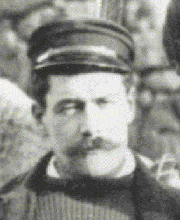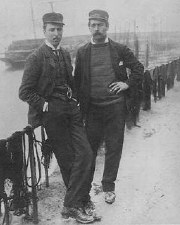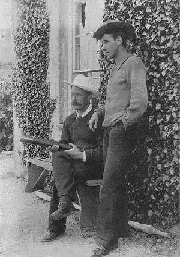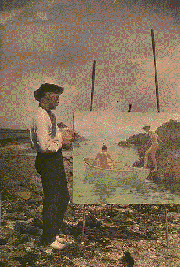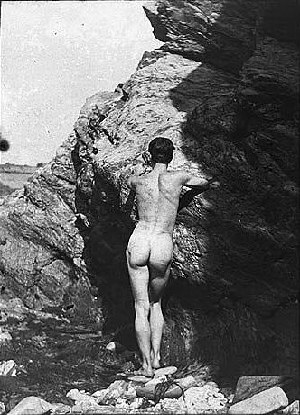Aged 14
Tuke
Tuke, Newlyn
Chevallier Tayler & Tuke,
Newlyn - c.1883
Tuke & Johnny Jackett
c.1896
Tuke painting
'The Embarcation'
on the beach at Swanpool
c.1912
Charlie Mitchell
Tuke's most loyal and
longstanding model.
(1885 -1957).
|
Henry Scott Tuke was born in 185
|
Henry
Scott Tuke was born in 1858 in York to Quaker parents. From 1860-1874,
until he was 16 years old, the family lived in Woodlane in Falmouth,
where his father practised as a doctor. It was then that Tuke would have
first seen ships going in and out of Falmouth Bay, which he drew
frequently. In 1874 Tuke moved with his parents to London.
He was
educated at the Slade School of Art, London, in 1875, under Alphonse
Legros and Sir Edward Poynter. In 1877 he won a Slade scholarship and in
1880 travelled to Italy. He went on to study in Florence, where he made
his first nude life drawings, an important revelation to him of light,
colour and the human form. From 1881 to 1883 he was in Paris, where he
studied with the French history painter Paul Laurens and met the
American painter John Singer Sargent. He also met Jules Bastien-Lepage,
who encouraged his studies en plein air. Admiring Bastien-Lepage's
practice of focusing different areas of a painting by degrees of finish,
Tuke adopted this in his own mature work.
In 1883
Tuke returned to Cornwall to live in Newlyn, where he associated with
artists such as T. C. Gotch and Stanhope Forbes, and was a
founder-member of the Newlyn school. But it was Falmouth that he was to
make his real home, and in 1885 he settled in a cottage on Pennance
Point overlooking Falmouth Bay, because there he could combine his two
great passions, painting and sailing, and he spent the rest of his life
based there. His fascination with ships never left him and after
completing his studies at the Slade in London and travelling abroad to
France and Italy to study painting, it was inevitable that Tuke would
return to both the subject and the place.
In 1886,
Tuke purchased an old French brigantine, the Julie of Nantes, which was
in a poor state and was in need of major renovation. He bought her for
£41, approximately the price he got for a small painting at the time. He
and his friends, Arthur Tanner, John Downing and Jim Diamond, stripped
her lower decks and converted her into a floating studio for Tuke to
paint from, and living quarters where he could pose his models and
entertain his friends. It was to become the setting for many of his
paintings including, Our Jack, 1886, Jack in the Rigging.
|
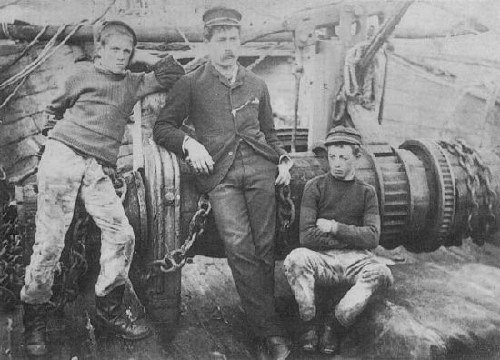 Jack Rowling (left), Tuke and Jim Dimond on the Julie of Nantes c.1885
Henry Scott Tuke was born in 185
|
Early in
his career, he produced narrative or anecdotal plein-air paintings of
the life of the Cornish fishing community. In his most famous oil
painting All Hands to the Pump! (1888-89), for example, seven figures
aboard a sailboat on a violent, stormy sea exercise their strength and
endurance to fight the elements. It is a typical example, showing his
alertness to tensions and movements in the human body and his ability to
combine classical compositional principles with naturalistic detail,
while giving coherence by sensitive rendering of atmosphere.
Early in
his career, he produced narrative or anecdotal plein-air paintings of
the life of the Cornish fishing community. In his most famous oil
painting All Hands to the Pump! (1888-89), for example, seven figures
aboard a sailboat on a violent, stormy sea exercise their strength and
endurance to fight the elements. It is a typical example, showing his
alertness to tensions and movements in the human body and his ability to
combine classical compositional principles with naturalistic detail,
while giving coherence by sensitive rendering of atmosphere.
In the
late 1880s, Henry Scott Tuke became part of a circle of poets and
writers who wrote about and discussed the beauty of male youth. Tuke's
paintings typically celebrate male beauty, as well as the artist's
lifelong love of the sea, swimming, and sailing. He also met Oscar Wilde
in the 1880s and developed connections with the Uranian poets and
writers who celebrated the adolescent male. He wrote a sonnet to youth
that was published anonymously in the journal The Artist and also
contributed an essay to The Studio, another journal that published
Uranian verse and essays.
In 1892
Tuke travelled to Italy, Corfu and Albania; thereafter his palette
lightened dramatically, and his technique gained a new Impressionistic
freedom. The nude adolescent male emerged as his principal motif in such
pictures as August Blue (1893-94). His admiration of James McNeill
Whistler appears in the creation of mood at the expense of narrative and
in his preference for evocative titles. An implicit homoerotic element
caused some unease at the time. In several canvases from this period,
Tuke attempts to situate his studies of male nudes within mythological
contexts. Among them there is Cupid and Sea Nymphs (1898-99).
In 1886
Tuke was a founder-member of the New English Art Club and in 1900 he was
elected an ARA. While attempting to discover in which settings to
position his nudes, Tuke realized that he desired to examine the human
form separate from any meaning-laden context. During the 1890s, he began
to render nude figures without reference to mythological or narrative
themes. This method particularly suited Tuke: his handling of paint
became freer, and he began using bold, fresh colour.
August
Blue (1893-1894), one of the most famous paintings from this period, is
a study of four nude youths bathing from a boat in crystal clear water
under bright blue skies. The work conveys a sense of enjoyment, of the
simple innocence of sunlight on flesh, sea, and sky. With August Blue,
Tuke established a genre that celebrates male beauty and the seeming
timelessness of youth. Tuke's paintings of nude youths illustrate
sensual, rather than sexual, feelings. They are not explicit either in
the relationships they describe or in the details of the body.
He
acquired a London studio where he spent the winters, usually working on
portrait commissions. His work in this field was much admired, and he
painted such notable figures as the cricketer W. G. Grace. Among his
best known portraits is that of soldier and writer T. E. Lawrence.
Although he was also an accomplished portraitist, most of his works
depict young men who swim, dive, and lounge on a boat or on the beach.
The oil
painting Noonday Heat (1903), for example, presents two youths who,
relaxing on the beach, are completely engrossed in their own private
world. They look at one another, perhaps engaged in conversation. Since
neither of them addresses the viewer, their relationship seems intimate,
exclusive, and ambiguous. Similarly, the watercolour Two Boys on a Beach
(1909) captures a close, intense relationship. In this work, the absence
of a horizon heightens the feeling of intimacy.
"Tuke only
rarely painted the genitals of his models, thereby de-emphasizing a
sexual reading of his works."
The artist
generally arranged his models so that anatomical details are concealed.
In frontal views, shadows or draped pieces of clothing obscure the
genitals. Tuke's de-emphasis of the sexual may explain why his work, and
his close friendships with many of his models, created no scandals.
An
accomplished watercolourist, in 1911 he became a member of the Royal
Watercolour Society. He also worked in pastels and executed a single
sculpture, The Watcher, of which five bronze casts were made.
Henry
Scott Tuke worked outside the mainstream of his contemporaries. During a
time when smooth, concealed brushstrokes were in vogue, Tuke favoured
rough, visible brushstrokes. He excelled at combining this type of
brushstroke with colour to produce unusual lighting effects that stall
the viewer's eye on the nude male body.
Tuke also
moved away from the popular historical and mythological scenes, indeed
from any type of narration, and studied everyday life as a worthy
subject matter. He was well known for his society portraits and his
paintings of the male nude but a major element in Tuke's work was his
devotion to the sailing ship. There is a poignancy in the fact that the
working ship in sail just survived the length of his life.
He was
made an associate member of the Royal Academy in 1900, and a full member
in 1914. A special celebration dinner was held in the Society's building
to honour him. His painting style and subject-matter remained
substantially unchanged: Aquamarine (1928), probably his last easel
painting, closely resembles the earlier Ruby, Gold and Malachite (1901).
In later
pictures, however, the models are no longer portraits, but interchange
heads and bodies as vehicles of Tuke's vision. Impersonality and
detachment combined with sincere commitment to subject and atmosphere
characterize his mature style and challenged artistic expectations of
the time, broadening the parameters of British plein-air painting.
In 1923
Tuke visited Jamaica and Central America, producing some fine
watercolours. Penetrating the interior of Belize, however, he became ill
and was forced to return home. He never fully recovered his health,
although his passion for travel remained undiminished. After a long
illness, Tuke died at Falmouth in 1929, and is buried in Falmouth
Cemetery. His work can be seen in public collections throughout Britain,
including Falmouth, Plymouth, Truro, Bristol, Leeds, Nottingham and
London. Many Tuke originals are now owned by Elton John.
|
|


